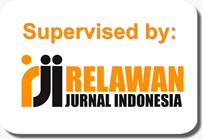THE IMPACT OF LEARNING CULTURE ON READINESS TO ONLINE LEARNING THROUGH LEARNING SATISFACTION AS INTERVENING VARIABLE IN THE INDUSTRIAL ERA 4.0
Abstract
Full Text:
PDF (Bahasa Indonesia)References
DAFTAR PUSTAKA
Allen, I. E., & Seaman, J. (2013). Changing course: Ten years of tracking online education in the United States. Sloan Consortium. PO Box 1238, Newburyport, MA 01950.
Aparicio, M., Bacao, F., & Oliveira, T. (2016). Cultural impacts on e-learning systems' success. The Internet and Higher Education, 31, 58-70.
Arikunto, Suharsini. 2010.Prosedur Penelitian Suatu Pendekatan Praktik. Jakarta: PT. Rineka Cipta
Bhuasiri, W. Xaymoungkhoun O. Zo H. Rho JJ. Ciganek AP (2012). Critical success factors for e-learning in developing countries: a comparative analysis between ICT experts and faculty. Comp. Edu, 58, 843-855.
Bora, M. A. (2017). Analisa Kepuasan Penggunaan E-Learning Cloud Sekolah Tinggi Teknik (STT) Ibnu Sina Batam. Jurnal Industri Kreatif (JIK), 1(01), 55-62.
Borotis, S., & Poulymenakou, A. (2004). E-learning readiness components: Key issues to consider before adopting e-learning interventions. In E-Learn: World Conference on E-Learning in Corporate, Government, Healthcare, and Higher Education (pp. 1622-1629). Association for the Advancement of Computing in Education (AACE).
Chang, I-Ying, Chang, Wan-Yu. 2012. “The Effect of Student Learning Motivation on Learning Satisfaction”. International Journal of Organizational Innovation, 4(3), 281-305. Diunduh 23 Desember 2016 dari http://search.proquest.com/docview/921995037
Cigdam, H., & Yildirim, O. G. (2014). Effects of students' characteristics on online learning readiness: A vocational college example. Turkish Online Journal of Distance Education, 15(3), 80-93.
Ghozali, I. 2008. Structural Equation Modeling: Alternative Method with Partial Least Square (Pls). Semarang, Indonesia
Hamalik, Oemar. 2013. Kurikulum dan Pembelajaran. Jakarta: Bumi Aksara
Hosseini, S. Y., Salimifard, K., & Yadollahi, S. (2017). E-learning readiness and the effects of organizational culture. In Organizational Culture and Behavior: Concepts, Methodologies, Tools, and Applications (pp. 1299-1313). IGI Global.
Hung, M. L., Chou, C., Chen, C. H., & Own, Z. Y. (2010). Learner readiness for online learning: Scale development and student perceptions. Computers & Education, 55(3), 1080-1090.
Jogiyanto dan Abdillah, Willy. (2009). Konsep dan Aplikasi PLS Untuk Penelitian Empiris. Yogyakarta : Fakultas Ekonomika dan Bisnis UGM
Kaminski, K., Switzer, J., & Gloeckner, G. (2009). Workforce readiness: A study of university students’ fluency with information technology. Computers & Education, 53(2), 228-233.
Kaur, K., & Zoraini Wati, A. (2004). An assessment of e-learning readiness at Open University Malaysia. -, 1017-1022.
Kranzow, J. (2013). Faculty leadership in online education: Structuring courses to impact student satisfaction and persistence. Journal of Online Learning and Teaching, 9(1), 131.
Londong, D. (2012). Kepuasan Pelanggan (Customer Satisfaction). dedylondong. blogspot. com.
Mungania, P. (2003). The seven e-learning barriers facing employees. The Masie Centre.
Nistor, N., & Neubauer, K. (2010). From participation to dropout: Quantitative participation patterns in online university courses. Computers & Education, 55(2), 663-672.
Park, J. H., & Choi, H. J. (2009). Factors influencing adult learners' decision to drop out or persist in online learning. Journal of Educational Technology & Society, 12(4), 207-217.
Pillay, H., Irving, K., & Tones, M. (2007). Validation of the diagnostic tool for assessing tertiary students’ readiness for online learning. High Education Research & Development, 26(2), 217-234.
Robbins, S. P., & Judge, T. A. (2007). Organizational culture. Organizational behavior, 28-50.
Slameto. 2010. Belajar dan Fakor-Faktor Yang Mempengaruhinya.Jakarta: Rineka Cipta
Sobel, M. E. (1982). Asymptotic confidence intervals for indirect effect in structural equation models. In S. Leinhardt (Ed.), Sociological Methodology 1982 (pp. 290-312).Washington DC: American Sociological Association
Yilmaz, R. (2017). Exploring the role of e-learning readiness on student satisfaction and motivation in flipped classroom. Computers in Human Behavior, 70, 251-260.
DOI: https://doi.org/10.31846/jae.v7i3.248
Refbacks
- There are currently no refbacks.

This work is licensed under a Creative Commons Attribution-NonCommercial-NoDerivatives 4.0 International License.
e-Jurnal Apresiasi Ekonnomi Indexed by:












